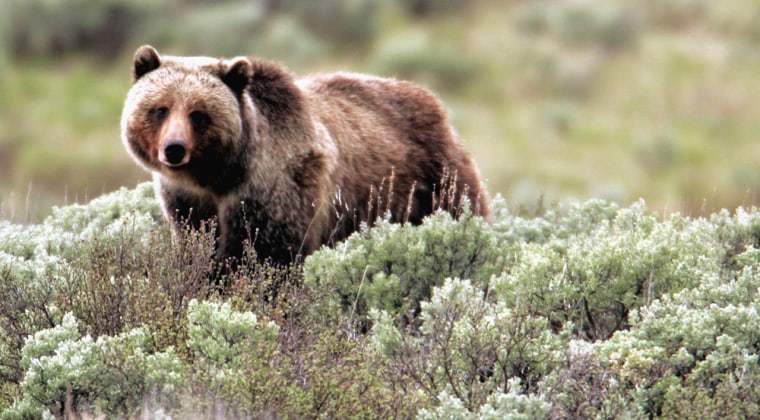Grizzly bear numbers in and around Yellowstone National Park have hit their highest level in decades — driving increased conflicts with humans as some bears push out of deep wilderness and into populated areas.
Scientists from a multi-agency research team announced Wednesday that at least 603 grizzlies now roam the Yellowstone area of Wyoming, Montana and Idaho. That's more than three times the number in 1975, when hunting was outlawed and the species placed on the endangered list.
But more bears also means more run-ins with humans. Two people have been fatally mauled by grizzlies in 2010 — one west of Cody, Wyo., and another near Cooke City, Mont.
In the latest encounter, on Wednesday, a hunter west of Cody, Wyo. reported to authorities that he was attacked by a bear and killed the animal in self-defense. The man, whose name was not available, suffered lacerations to the leg but the injuries were not considered life threatening.
The death of the grizzly was not immediately confirmed. It would mark the 46th grizzly killed or removed from the wild this year. Factoring in unreported killings, wildlife officials estimate at least 62 bears killed or removed so far this year.
The last time so many bears died, in 2008, the population dipped the following year.
Still, the head of the grizzly research team said only 11 of the known bear deaths were adult females, dampening worries that the species' long-term recovery could stall.
"Our population is strong, our counts of females are high," said Chuck Schwartz, a U.S. Geological Survey scientist who heads the Interagency Grizzly Bear Study Team. "Right now, all indications are we haven't turned into negative trajectory."
Wildlife advocates have been more skeptical of the grizzly's future. They point to the decimation of a key bear food source — the nuts of whitebark pine trees — as a potential threat to the species' long-term survival. Vast stands of the trees are dead or dying because of a beetle infestation.
Government scientists including Schwartz said bears are unlikely to be impacted by the loss of a single food source and can adapt to the change.
Between 2004 and 2008, the area inhabited by Yellowstone grizzlies expanded 34 percent, to more than 22,000 square miles.
Wildlife managers said that push outward from Yellowstone National Park has created a number of "hot spots" for conflicts, including around Gardiner, Mont., West Yellowstone, Mont. and along the North Fork and South Fork of the Shoshone River west of Cody, Wyo.
In Wyoming, that expansion helped fuel a record 251 conflicts between bears and humans so far this year — ranging from tipped over garbage cans and killed livestock, to maulings of hunters.
The best wildlife habitat in the state is now full of bears, forcing some of the animals to spill onto farms and residential areas, said Mark Bruscino, carnivore specialist with the Wyoming Game and Fish Department.
"We're dealing with bears that are in and around people constantly," Bruscino said. "There's no place to put them because the wildland habitat is full in our state."
Despite their growing numbers, Yellowstone-area bears remain protected as an endangered species. The U.S. Fish and Widlife Service took away those protections in 2007, but they were restored last year by a federal judge in Missoula.
That decision is under appeal. Federal grizzly recovery coordinator Chris Servheen said Wednesday that a decision on the appeal is not expected until 2012.
